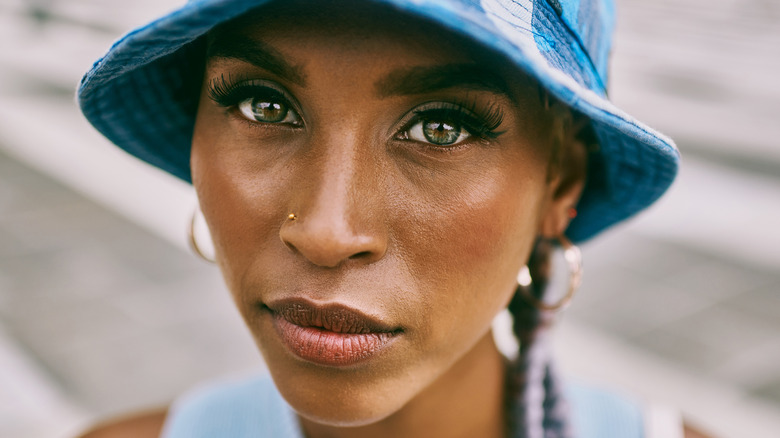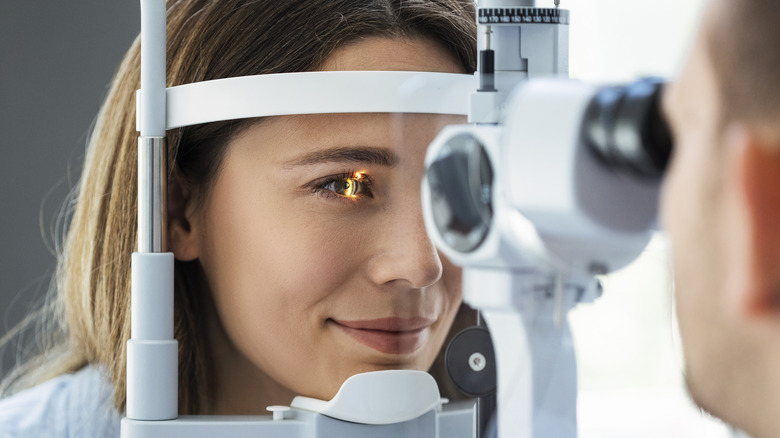The Disadvantages Of Having Green Eyes, Explained To Us By An Ophthalmologist
Green eyes may be a symbol of envy, but they're also a rarity associated with beauty — just look to stunning celebrities like Hayden Panettiere, Emma Stone, Scarlett Johansson, Lindsay Lohan, and Elizabeth Olsen for proof. There's something captivating about the shade, ranging from emerald to olive, which might explain why more respondents in an AllAboutVision.com survey chose green as the most attractive eye color than any other hue.
However, green eyes aren't as mysterious as they may seem — and they could even come with a few disadvantages. We tapped Dr. John T. Lind, associate professor of ophthalmology at the Indiana University School of Medicine, for insights on the alluring feature. As he exclusively shares with Glam, the grassy color all comes down to the iris, the part of the eye located behind the cornea surrounded by the white part. "What determines eye color is the amount of melanin that is in the iris. Due to genetics and environmental factors, the amount of melanin varies in each individual," Dr. Lind explains. "People with green irides tend to have less pigment."
Put simply, the amount of dark pigment is generally the only thing setting green eyes apart from blue or brown ones. Still, this pigment can play a major role in eye health, and green-eyed folks may run into unique issues if they don't properly care for their peepers.
People with green eyes may be more at risk for some health conditions
The light, jade-colored effect that makes green eyes stand out could also make them more susceptible to some serious conditions. One such condition, according to Dr. John T. Lind, is ocular melanoma. "Melanoma is a life-threatening cancer that can spread to other parts of the body," the ophthalmologist exclusively tells Glam, adding that people with blue and green eyes are also more at risk of developing other types of skin cancer. According to the Mayo Clinic, experts aren't sure what causes melanoma of the eye, though light eyes and light skin are considered risk factors.
Macular degeneration is another condition that may occur more often in people with light and green-colored eyes, says Dr. Lind. The disease affects the retina and can result in a loss of central vision. "Another condition is called heterochromia, where each iris can have different colors," he reveals. "This could be caused by many things including trauma, other ocular conditions like inflammation, [or] a neurologic condition called Horner's syndrome." Famous faces with heterochromia include Mila Kunis, who underwent surgery to correct her eyes, and Kate Bosworth. If you notice your eyes vary in color or change tint over time, Dr. Lind suggests visiting an eye care professional to rule out serious conditions.
Green eyes tend to be more sensitive to light
If you have green eyes and feel easily blinded by the sun and other bright lights, it's not all in your head. "Patients with lighter colored irides tend to be more light sensitive," Dr. John T. Lind exclusively tells Glam. "This is likely due to the lack of melanin of the iris and patients having greater glare due to light scatter." Yep, that's why you can't stand to look at the sky for more than five seconds on a sunny day while your brown-eyed friend isn't as affected.
The best thing you can do, according to Dr. Lind, is block out harsh lights with sunglasses. He recommends choosing a pair that protects the eyes against UVA and UVB radiation and that have anti-reflective and polarized lenses. "Patients that are predisposed to reduced contrast sensitivity (glaucoma and macular degeneration) can try yellow-tinted glasses instead of gray tint as yellow tint can actually improve contrast sensitivity," he adds. Did someone say "lemon girl summer"?
How to care for green eyes
Caring for your eyes isn't just important to protect their gorgeous green color — it's essential to maintain their health, too. When you neglect your peepers, you could be at increased risk of suffering from vision loss, damage, and eye diseases, per Harvard Health Publishing. Thankfully, maintaining eye health doesn't have to be complicated. Dr. John T. Lind's first exclusive piece of advice: Stay on top of regular visits with your eye doctor. "This is perhaps more important in patients with green eyes due to the increased risks of eye-related and systemic associations," he shares. If you have vision problems that require glasses or contacts, visit an eye doctor annually, WebMD suggests. If your eyesight is in tip-top shape, see a professional at least once in your 20s and twice in your 30s. Adults in their 40s and older should see an eye doctor more often — once every one or two years is a good rule of thumb.
There are ways to protect your eyes in everyday life, too. Just as SPF is always necessary, UVA and UVB-blocking sunglasses are must-haves for your eyes. Dr. Lind also urges — whether your irises are green or not — to exercise regularly, follow a balanced diet, and avoid smoking. These healthy habits can do wonders for both your eyes and your entire body.



